2009 MERCEDES-BENZ GL SUV ground clearance
[x] Cancel search: ground clearancePage 120 of 309

The engaged differential appears in the multi-
function display:
A
The differential lock for the transfer case
is locked.
The differential locks are not controlled auto-
matically. The steerability of the vehicle is
restricted considerably. Drive carefully and
accelerate gently for optimum traction.
You can switch back to automatic mode at
any time. For safety reasons, the differential
locks disengage automatically at speeds
above 50 km/h. If you stop the vehicle and
switch off the ignition for longer than ten sec-
onds, the differential locks switch back to
automatic mode.
Message in the multi-function display
Diff. lock system overheated.
Wait briefly
The differential lock system has overheated
and briefly disengaged.
X Continue driving.
The differential locks cool off and are soon
available once again. Driving systems
Overview of driving systems
The vehicle's driving systems are described
on the following pages:
R cruise control, Distronic *and Speedtronic,
which are used to control the speed of the
vehicle
R Adaptive damping system (ADS), for indi-
vidual adjustment of suspension tuning R
level control, for individual adjustment of
ground clearance
R PARKTRONIC*, which assists you in park-
ing and manoeuvring
R reversing camera*, which assists you when
parking and manoeuvring
The ABS, BAS, adaptive brake lights, ESP ®
,
EBV and 4ETS driving safety systems and the
distance warning function* are described in
the "Driving safety systems" section
(Y page 49). Cruise control
Cruise control maintains a constant road
speed for you. It brakes automatically in order
to avoid exceeding the set speed. On long and
steep downhill gradients, especially if the
vehicle is laden or towing a trailer, you must
select shift range 1,2or 3in good time. By
doing so, you will make use of the braking
effect of the engine, which relieves the load
on the brake system and prevents the brakes
from overheating and wearing too quickly. G
Risk of accident
Do not change down for additional engine
braking on a slippery road surface. This could
cause the drive wheels to lose their grip and
the vehicle could skid.
Use cruise control only if road and traffic con-
ditions make it appropriate to maintain a
steady speed for a prolonged period. You can
store any road speed above 30 km/h. G
Risk of accident
Cruise control cannot take account of road
and traffic conditions.
Always pay attention to traffic conditions
even when cruise control is activated.
Cruise control is only an aid designed to assist
driving. You are responsible for the vehicle's
speed and for braking in good time. Driving systems
117Controls
* optional
X164_AKB; 2; 3, en-GB
wobuchh
,V ersion: 2.11.8.1
2009-03-31T14:14:58+02:00 - Seite 117 Z
Dateiname: 6515431202_buchblock.pdf; erzeugt am 01. Apr 2009 00:17:20; WK
Page 133 of 309
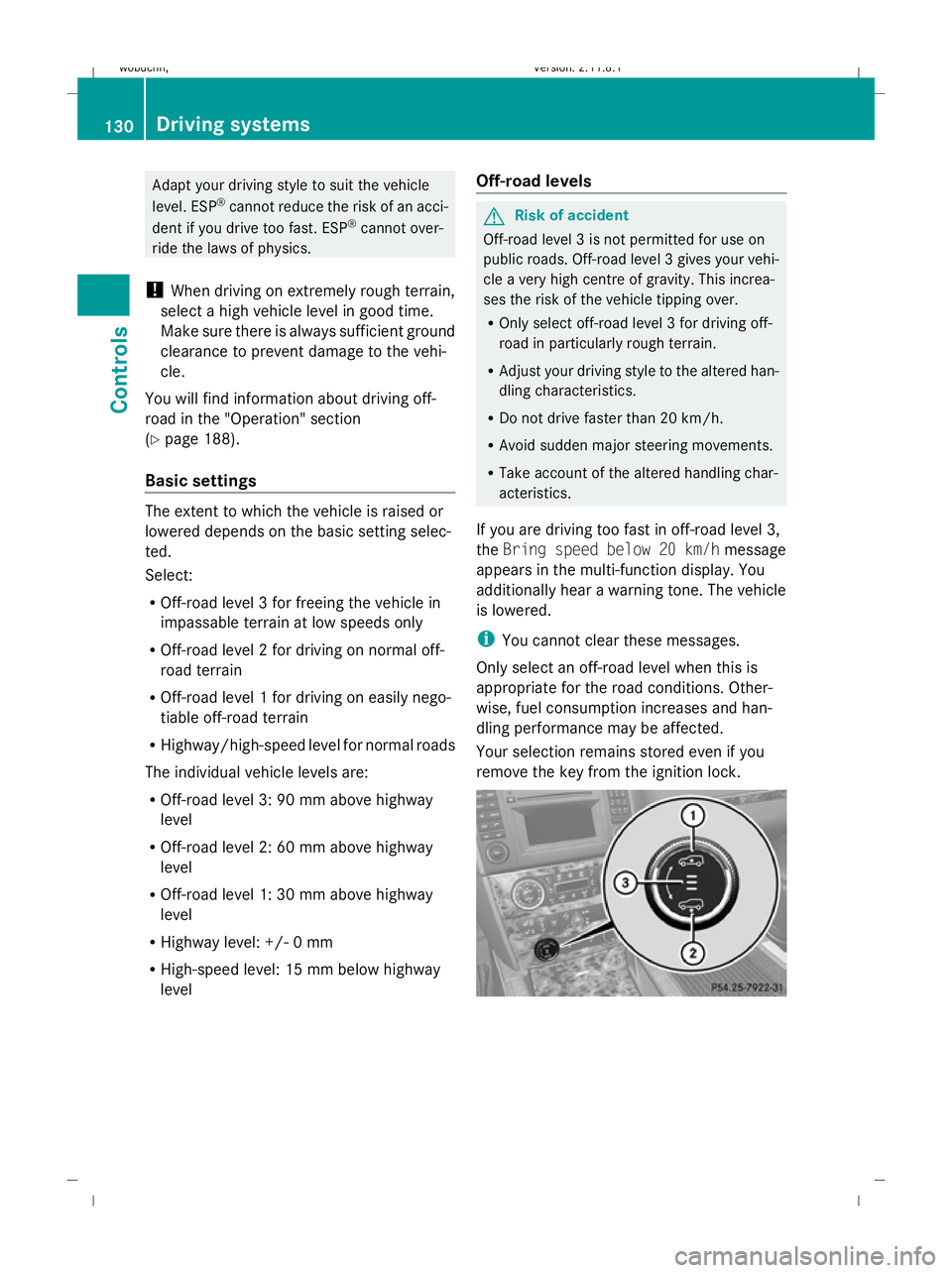
Adapt your driving style to suit the vehicle
level. ESP ®
cannot reduce the risk of an acci-
dent if you drive too fast. ESP ®
cannot over-
ride the laws of physics.
! When driving on extremely rough terrain,
select a high vehicle level in good time.
Make sure there is always sufficient ground
clearance to prevent damage to the vehi-
cle.
You will find information about driving off-
road in the "Operation" section
(Y page 188).
Basic settings The extent to which the vehicle is raised or
lowered depends on the basic setting selec-
ted.
Select:
R Off-road level 3 for freeing the vehicle in
impassable terrain at low speeds only
R Off-road level 2 for driving on normal off-
road terrain
R Off-road level 1 for driving on easily nego-
tiable off-road terrain
R Highway/high-speed level for normal roads
The individual vehicle levels are:
R Off-road level 3: 90 mm above highway
level
R Off-road level 2: 60 mm above highway
level
R Off-road level 1: 30 mm above highway
level
R Highway level: +/- 0 mm
R High-speed level: 15 mm below highway
level Off-road levels G
Risk of accident
Off-road level 3 is not permitted for use on
public roads. Off-road level 3 gives your vehi-
cle a very high centre of gravity. This increa-
ses the risk of the vehicle tipping over.
R Only select off-road level 3 for driving off-
road in particularly rough terrain.
R Adjust your driving style to the altered han-
dling characteristics.
R Do not drive faster than 20 km/h.
R Avoid sudden major steering movements.
R Take account of the altered handling char-
acteristics.
If you are driving too fast in off-road level 3,
the Bring speed below 20 km/h message
appears in the multi-function display. You
additionally hear a warning tone. The vehicle
is lowered.
i You cannot clear these messages.
Only select an off-road level when this is
appropriate for the road conditions. Other-
wise, fuel consumption increases and han-
dling performance may be affected.
Your selection remains stored even if you
remove the key from the ignition lock. 130
Driving systemsControls
X164_AKB; 2; 3, en-GB
wobuchh,
Version: 2.11.8.1 2009-03-31T14:14:58+02:00 - Seite 130
Dateiname: 6515431202_buchblock.pdf; erzeugt am 01. Apr 2009 00:17:24; WK
Page 192 of 309
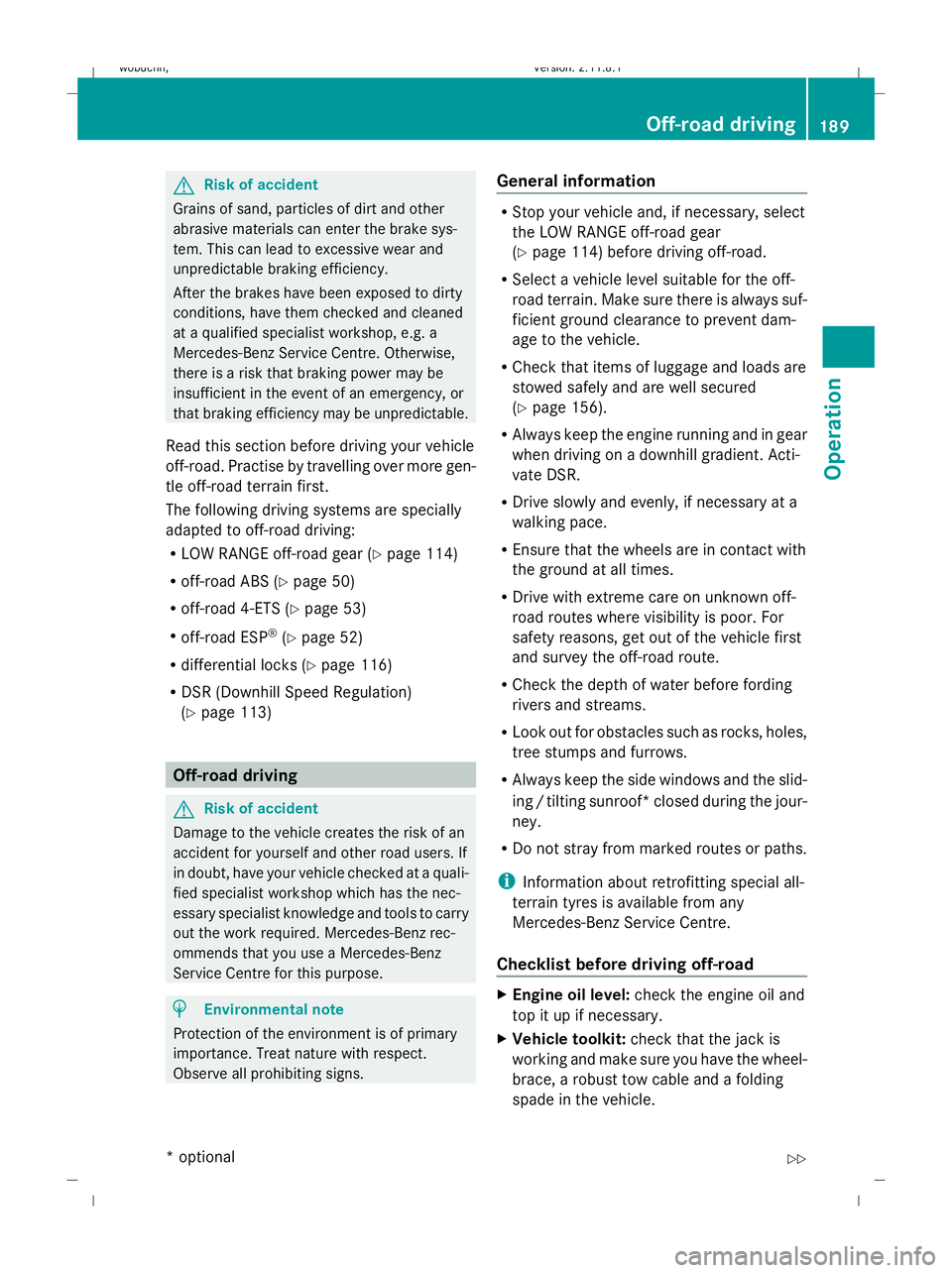
G
Risk of accident
Grains of sand, particles of dirt and other
abrasive materials can enter the brake sys-
tem. This can lead to excessive wear and
unpredictable braking efficiency.
After the brakes have been exposed to dirty
conditions, have them checked and cleaned
at a qualified specialist workshop, e.g. a
Mercedes-Benz Service Centre. Otherwise,
there is a risk that braking power may be
insufficient in the event of an emergency, or
that braking efficiency may be unpredictable.
Read this section before driving your vehicle
off-road. Practise by travelling over more gen-
tle off-road terrain first.
The following driving systems are specially
adapted to off-road driving:
R LOW RANGE off-road gear (Y page 114)
R off-road ABS (Y page 50)
R off-road 4-ETS (Y page 53)
R off-road ESP ®
(Y page 52)
R differential locks (Y page 116)
R DSR (Downhill Speed Regulation)
(Y page 113) Off-road driving
G
Risk of accident
Damage to the vehicle creates the risk of an
accident for yourself and other road users. If
in doubt, have your vehicle checked at a quali-
fied specialist workshop which has the nec-
essary specialist knowledge and tools to carry
out the work required. Mercedes-Benz rec-
ommends that you use a Mercedes-Benz
Service Centre for this purpose. H
Environmental note
Protection of the environment is of primary
importance. Treat nature with respect.
Observe all prohibiting signs. General information R
Stop your vehicle and, if necessary, select
the LOW RANGE off-road gear
(Y page 114) before driving off-road.
R Select a vehicle level suitable for the off-
road terrain. Make sure there is always suf-
ficient ground clearance to prevent dam-
age to the vehicle.
R Check that items of luggage and loads are
stowed safely and are well secured
(Y page 156).
R Always keep the engine running and in gear
when driving on a downhill gradient. Acti-
vate DSR.
R Drive slowly and evenly, if necessary at a
walking pace.
R Ensure that the wheels are in contact with
the ground at all times.
R Drive with extreme care on unknown off-
road routes where visibility is poor. For
safety reasons, get out of the vehicle first
and survey the off-road route.
R Check the depth of water before fording
rivers and streams.
R Look out for obstacles such as rocks, holes,
tree stumps and furrows.
R Always keep the side windows and the slid-
ing /tilting sunroof* closed during the jour-
ney.
R Do not stray from marked routes or paths.
i Information about retrofitting special all-
terrain tyres is available from any
Mercedes-Benz Service Centre.
Checklist before driving off-road X
Engine oil level: check the engine oil and
top it up if necessary.
X Vehicle toolkit: check that the jack is
working and make sure you have the wheel-
brace, a robust tow cable and a folding
spade in the vehicle. Off-road driving
189Operation
* optional
X164_AKB; 2; 3, en-GB
wobuchh,
Version: 2.11.8.1 2009-03-31T14:14:58+02:00 - Seite 189 Z
Dateiname: 6515431202_buchblock.pdf; erzeugt am 01. Apr 2009 00:17:49; WK
Page 196 of 309

R
Drive quickly to overcome the rolling resist-
ance. The vehicle could otherwise dig itself
into the sand.
R Drive in the tracks of other vehicles, if pos-
sible. Make sure that the ruts are not too
deep, that the sand is firm enough and that
your vehicle has sufficient ground clear-
ance. Ruts
Observe the following rules when driving
along ruts in off-road terrain or on roads with
loose gravel:
! Check that the ruts are not too deep and
that your vehicle has sufficient clearance.
Otherwise, your vehicle could be damaged
or bottom out and get stuck.
R Select the LOW RANGE off-road gear
(Y page 114).
R Select a higher vehicle level.
R Avoid high engine speeds.
R Select shift range 1.
R Drive slowly.
R Where ruts are too deep, drive with the
wheels on one side on the middle section
of turf if possible. Driving abroad
Points to remember
An extensive Mercedes-Benz Service network
is also available in other countries. The
Service Hotline's current telephone numbers
for use when you are abroad are to be found
in the "Service24h" chapter of the Service
Booklet.
Only low-octane fuel is available in certain
countries.
You can find further information about fuel
grades on (Y page 172). Symmetrical dipped beam
If your journey takes you to countries where
vehicles are driven on sides of the road oppo-
site to the country in which the vehicle is reg-
istered, your headlamps must be switched to
symmetrical dipped beam. Oncoming traffic
will be dazzled less.
X Have the headlamps switched over at a
qualified specialist workshop, e. g. a
Mercedes-Benz Service Centre. G
Risk of accident
Remember to set the headlamps back to
asymmetrical dipped beam when you return
to driving on the same side of the road as that
of the country in which your vehicle was reg-
istered. You may otherwise dazzle the oncom-
ing traffic and could cause an accident. Trailer towing*
Folding out the ball coupling
Before you can tow a trailer with your vehicle,
you must fit the ball coupling.
The telescopic lever is under the boot/lug-
gage compartment mat on the left-hand side. G
Risk of accident
Make sure that the ball coupling is fully
engaged both when it is folded in and when it
is folded out. The indicator lamp is not lit.
Do not pull the telescopic lever if a trailer is
attached. The trailer could otherwise come
loose. Trailer towing*
193Operation
* optional
X164_AKB; 2; 3, en-GB
wobuchh
,V ersion: 2.11.8.1
2009-03-31T14:14:58+02:00 - Seite 193 Z
Dateiname: 6515431202_buchblock.pdf; erzeugt am 01. Apr 2009 00:17:50; WK
Page 224 of 309
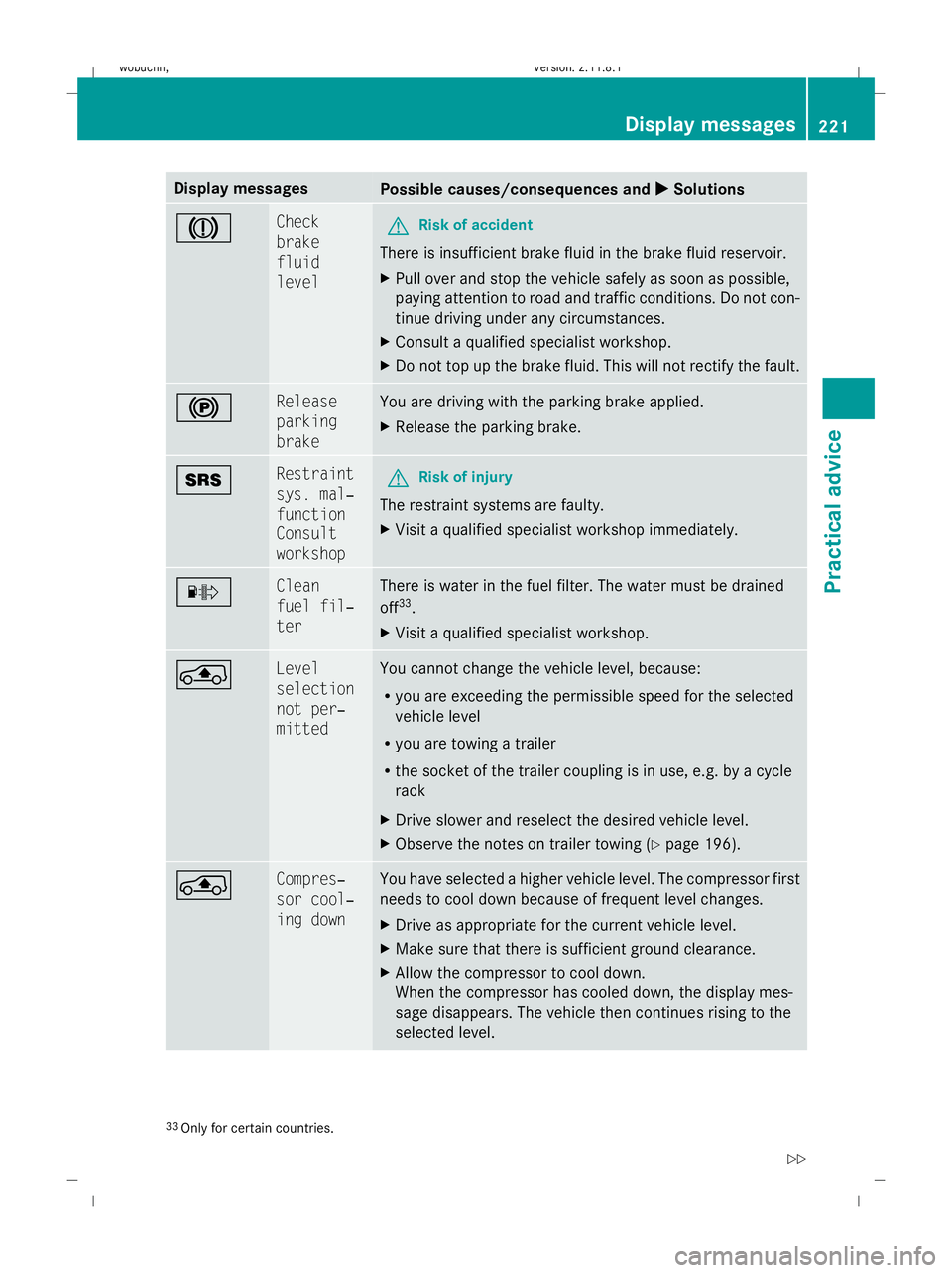
Display messages
Possible causes/consequences and
X
X Solutions J Check
brake
fluid
level
G
Risk of accident
There is insufficient brake fluid in the brake fluid reservoir.
X Pull over and stop the vehicle safely as soon as possible,
paying attention to road and traffic conditions. Do not con-
tinue driving under any circumstances.
X Consult a qualified specialist workshop.
X Do not top up the brake fluid. This will not rectify the fault. ! Release
parking
brake You are driving with the parking brake applied.
X
Release the parking brake. + Restraint
sys. mal‐
function
Consult
workshop
G
Risk of injury
The restraint systems are faulty.
X Visit a qualified specialist workshop immediately. · Clean
fuel fil‐
ter There is water in the fuel filter. The water must be drained
off
33
.
X Visit a qualified specialist workshop. ° Level
selection
not per‐
mitted You cannot change the vehicle level, because:
R
you are exceeding the permissible speed for the selected
vehicle level
R you are towing a trailer
R the socket of the trailer coupling is in use, e.g. by a cycle
rack
X Drive slower and reselect the desired vehicle level.
X Observe the notes on trailer towing (Y page 196).° Compres‐
sor cool‐
ing down You have selected a higher vehicle level. The compressor first
needs to cool down because of frequent level changes.
X
Drive as appropriate for the current vehicle level.
X Make sure that there is sufficient ground clearance.
X Allow the compressor to cool down.
When the compressor has cooled down, the display mes-
sage disappears. The vehicle then continues rising to the
selected level. 33
Only for certain countries. Display
messages
221Practical advice
X164_AKB; 2; 3, en-GB
wobuchh,V ersion: 2.11.8.1
2009-03-31T14:14:58+02:00 - Seite 221 Z
Dateiname: 6515431202_buchblock.pdf; erzeugt am 01. Apr 2009 00:17:59; WK
Page 225 of 309
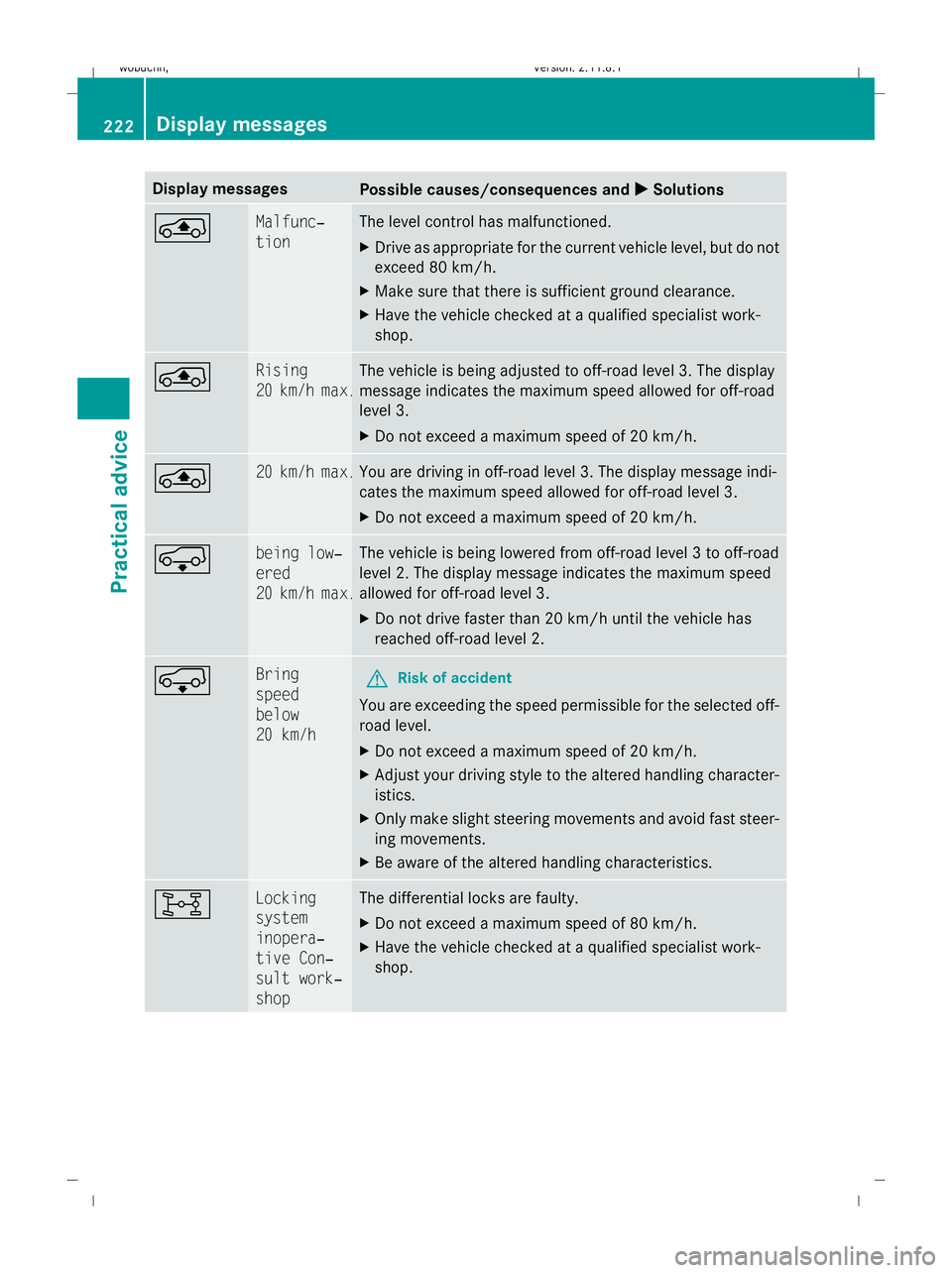
Display messages
Possible causes/consequences and
X
X Solutions ° Malfunc‐
tion The level control has malfunctioned.
X
Drive as appropriate for the current vehicle level, but do not
exceed 80 km/h.
X Make sure that there is sufficient ground clearance.
X Have the vehicle checked at a qualified specialist work-
shop. ° Rising
20 km/h max. The vehicle is being adjusted to off-road level 3. The display
message indicates the maximum speed allowed for off-road
level 3.
X
Do not exceed a maximum speed of 20 km/h. ° 20 km/h max. You are driving in off-road level 3. The display message indi-
cates the maximum speed allowed for off-road level 3.
X
Do not exceed a maximum speed of 20 km/h. Æ being low‐
ered
20 km/h max. The vehicle is being lowered from off-road level 3 to off-road
level 2. The display message indicates the maximum speed
allowed for off-road level 3.
X
Do not drive faster than 20 km/h until the vehicle has
reached off-road level 2. Æ Bring
speed
below
20 km/h
G
Risk of accident
You are exceeding the speed permissible for the selected off-
road level.
X Do not exceed a maximum speed of 20 km/h.
X Adjust your driving style to the altered handling character-
istics.
X Only make slight steering movements and avoid fast steer-
ing movements.
X Be aware of the altered handling characteristics. 8 Locking
system
inopera‐
tive Con‐
sult work‐
shop The differential locks are faulty.
X
Do not exceed a maximum speed of 80 km/h.
X Have the vehicle checked at a qualified specialist work-
shop. 222
Display
messagesPractical advice
X164_AKB; 2; 3, en-GB
wobuchh,V ersion: 2.11.8.1
2009-03-31T14:14:58+02:00 - Seite 222
Dateiname: 6515431202_buchblock.pdf; erzeugt am 01. Apr 2009 00:18:00; WK
Page 295 of 309

Vehicle data, GL 450 4MATIC
Vehicle dimensions
Vehicle length
(ECE)
5099 mm
Vehicle width
including exterior
mirrors
2124 mm
Minimum vehicle
height
38 1840 mm
Maximum vehicle
height
38 1950 mm
Minimum ground
clearance
38 202 mm
Maximum ground
clearance
38 307 mm
Ground clearance
when the suspen-
sion is set to High-
way level
38 217 mm
Wheel base
3075 mm
Vehicle weights
Unladen weight
(in accordance
with EC directive)
2430 kg
The unladen weight includes the driver
(68 kg), luggage (7 kg) and all fluids (fuel
tank 90% full). Items of optional equipment
increase the unladen weight and reduce the
maximum payload. Maximum roof
load
90 kg
You will find weight information specific to
the vehicle on the vehicle identification
plate (Y page 286). Vehicle data, GL 500 4MATIC
Vehicle dimensions
Vehicle length
(ECE)
5099 mm
Vehicle width
including exterior
mirrors 2124 mm
Minimum vehicle
height 39 1840 mm
Maximum vehicle
height
39 1950 mm
Minimum ground
clearance
39 202 mm
Maximum ground
clearance
39 307 mm
Ground clearance
when the suspen-
sion is set to High-
way level 39 217 mm
Wheel base
3075 mm
Vehicle weights
Unladen weight
(in accordance
with EC directive) 2445 kg
The unladen weight includes the driver
(68 kg), luggage (7 kg) and all fluids (fuel
tank 90% full). Items of optional equipment
increase the unladen weight and reduce the
maximum payload.
Maximum roof
load 90 kg
You will find weight information specific to
the vehicle on the vehicle identification
plate (Y page 286). 38
The value stated may vary due to the tyres fitted and the state of the suspension system.
39 The value stated may vary due to the tyres fitted and the state of the suspension system. 292
Vehicle data, GL 500 4MATICTechnical data
X164_AKB; 2; 3, en-GB
wobuchh,
Version: 2.11.8.1
2009-03-31T14:14:58+02:00 - Seite 292
Dateiname: 6515431202_buchblock.pdf; erzeugt am 01. Apr 2009 00:18:25; WK
Page 296 of 309
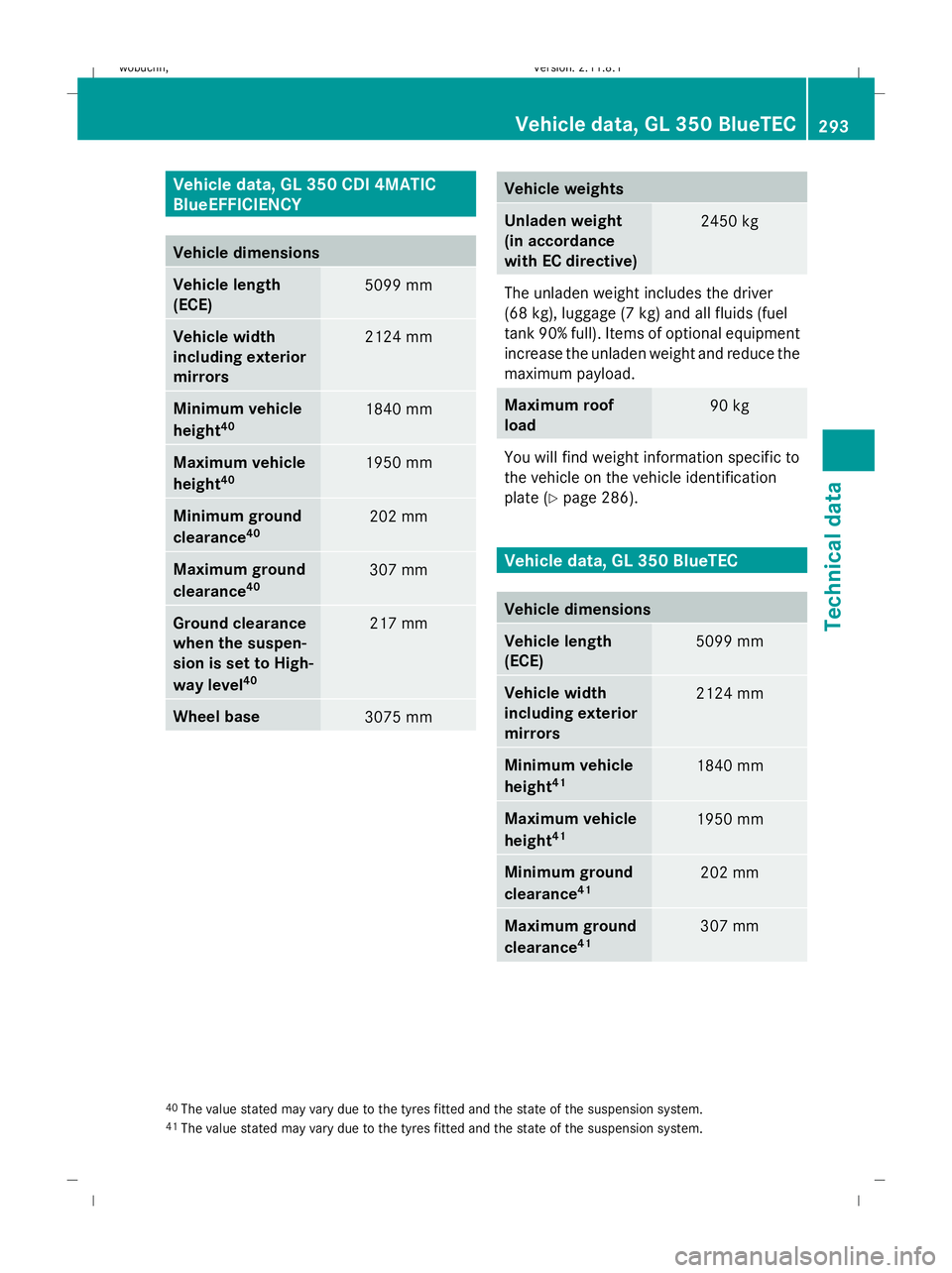
Vehicle data, GL 350 CDI 4MATIC
BlueEFFICIENCY Vehicle dimensions
Vehicle length
(ECE) 5099 mm
Vehicle width
including exterior
mirrors
2124 mm
Minimum vehicle
height
40 1840 mm
Maximum vehicle
height
40 1950 mm
Minimum ground
clearance
40 202 mm
Maximum ground
clearance
40 307 mm
Ground clearance
when the suspen-
sion is set to High-
way level
40 217 mm
Wheel base
3075 mm Vehicle weights
Unladen weight
(in accordance
with EC directive)
2450 kg
The unladen weight includes the driver
(68 kg), luggage (7 kg) and all fluids (fuel
tank 90% full). Items of optional equipment
increase the unladen weight and reduce the
maximum payload. Maximum roof
load
90 kg
You will find weight information specific to
the vehicle on the vehicle identification
plate (Y
page 286). Vehicle data, GL 350 BlueTEC
Vehicle dimensions
Vehicle length
(ECE)
5099 mm
Vehicle width
including exterior
mirrors
2124 mm
Minimum vehicle
height
41 1840 mm
Maximum vehicle
height
41 1950 mm
Minimum ground
clearance
41 202 mm
Maximum ground
clearance
41 307 mm
40
The value stated may vary due to the tyres fitted and the state of the suspension system.
41 The value stated may vary due to the tyres fitted and the state of the suspension system. Vehicle data, GL 350 BlueTEC
293Technical data
X164_AKB; 2; 3, en-GB
wobuchh, Version: 2.11.8.1 2009-03-31T14:14:58+02:00 - Seite 293 Z
Dateiname: 6515431202_buchblock.pdf; erzeugt am 01. Apr 2009 00:18:25; WK